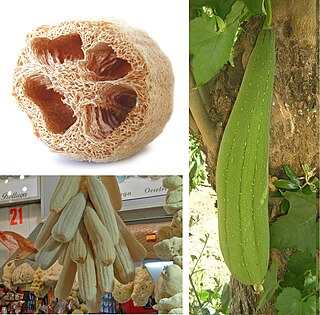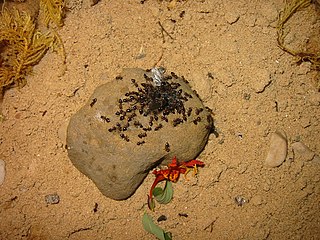
Luffa is a genus of tropical and subtropical vines in the cucumber family (Cucurbitaceae).

The Egyptian goose is a member of the duck, goose, and swan family Anatidae. It is native to Africa south of the Sahara and the Nile Valley.

Manetho is believed to have been an Egyptian priest from Sebennytos who lived in the Ptolemaic Kingdom in the early third century BC, during the Hellenistic period. He authored the Aegyptiaca in Greek, a major chronological source for the reigns of the pharaohs of ancient Egypt. It is unclear if he wrote his work during the reign of Ptolemy I Soter or Ptolemy II Philadelphos, but no later than that of Ptolemy III Euergetes.
The decade of the 1640s in archaeology involved some significant events.

The Egyptian free-tailed bat, also known as Egyptian guano bat or Egyptian nyctinome, is a species of bat in the family Molossidae.
Crematogaster atitlanica is a species of ant endemic to Guatemala .

Crematogaster is an ecologically diverse genus of ants found worldwide, which are characterised by a distinctive heart-shaped gaster (abdomen), which gives them one of their common names, the Saint Valentine ant. Members of this genus are also known as cocktail ants because of their habit of raising their abdomens when alarmed. Most species are arboreal. These ants are sometimes known as acrobat ants.

Luffa aegyptiaca, the sponge gourd, Egyptian cucumber, or Vietnamese luffa, is a species of Luffa cultivated for its fruit. The plant is an annual vine, native to South Asia and Southeast Asia.
The Seventh Dynasty of Egypt would mark the beginning of the First Intermediate Period in the early 22nd century BC but its actual existence is debated. The only historical account on the Seventh Dynasty was in Manetho's Aegyptiaca, a history of Egypt written in the 3rd century BC, where the Seventh Dynasty appears essentially as a metaphor for chaos. Since next to nothing is known of this dynasty beyond Manetho's account, Egyptologists such as Jürgen von Beckerath and Toby Wilkinson have usually considered it to be fictitious. In a 2015 re-appraisal of the fall of the Old Kingdom, the Egyptologist Hracht Papazian has proposed that the Seventh Dynasty was real and that it consisted of kings usually attributed to the Eighth Dynasty.

Crematogaster ashmeadi, commonly known as the acrobat ant, is an arboreal ant widespread in the Southeastern United States. It nests and forages almost exclusively above ground level, often found in treetops and on lianas. It is one of eleven species in the genus Crematogaster that is native to eastern North America. This ant species has been observed to raid wasp nests, including the species Mischocyttarus mexicanus, and to forage on their brood. It is the most dominant arboreal ant in the pine forests of the coastal plains of northern Florida. Colonies of these ants inhabit a majority of pine trees in the area, living in chambers in the outer bark of living trees that have been abandoned by bark-mining caterpillars, usually of the family Cossidae. C. ashmeadi does little to no excavation of its own, relying solely on chambers bored out by other insects.

Balanites aegyptiaca is a species of tree, classified as a member of either the Zygophyllaceae or the Balanitaceae. This tree is native to much of Africa and parts of the Middle East.
Crematogaster gordani species of ant in the subfamily Myrmicinae.

Crematogaster peringueyi is a southern African arboreal species of ant. They are commonly known as the black cocktail ant or swartwipgatmier (Afrikaans) for their colour and habit of arching their tails when alarmed.

Suaeda aegyptiaca is a species of plant in the family Amaranthaceae, and salt-tolerant plant (halophytes) that is distributed primarily throughout North Africa and West Asia. It is particularly common in salt-affected regions of southern Iran.
Crematogaster dohrni, is a species of ant of the subfamily Myrmicinae, which is a widespread species that can be found from Sri Lanka, India, Indonesia, Thailand, and China.

Crematogaster rogenhoferi, is a species of ant of the subfamily Myrmicinae, which can be found from Sri Lanka.
Crematogaster rothneyi, is a species of ant of the subfamily Myrmicinae.

The Egyptian sole is a species of flatfish in the true sole family, Soleidae. It lives on the sandy or muddy seabed of the Mediterranean Sea, and is now colonising the Red Sea. It often semi-immerses itself in the substrate. The upper side is greyish-brown while the underside is white. It grows to a maximum length of about 70 cm (28 in). This fish is used for human consumption and is prized as a food fish. It is caught mostly by trawling on the seabed.















